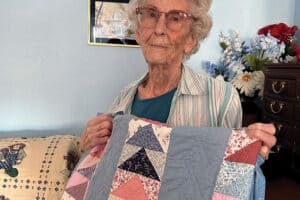It was on a fall morning in 1988 in the Colorado countryside that Barbara Jagoda first set her eyes on the shy, young colt.His name was Magna Terra Smoky. His owner found him too difficult to handle and was considering sending him to an uncertain ó and possibly deadly ó future at the auction house.But Jagoda, who admired the Arabian horse’s easy, fluid movement, had a much different future in mind.”I knew right away he was going to be my racehorse,” she said. “Just the way he was built and the way he moved.”And so Jagoda took him on, first as his trainer and later as his owner. With patience and love and horse savvy, she helped Smoky rise to the top of the Arabian racing world. She tells the story of that tumultuous journey in her book, simply titled “Magna Terra Smoky.”Jagoda’s grandfather was the first to put her atop a horse; she was only 2 and has no memories of it, but she does remember growing up with a love of horses. Perhaps it was in her genes; as she writes in her book, “Grandpa had been quite the horseman in his younger days, and he had won numerous awards for his horseman skills while serving in the Royal Horse Artillery in India.”Born in England, Jagoda grew up in Canada; her father was a member of the Royal Canadian Air Force. She moved to Colorado after her father was transferred to NORAD. She graduated from the University of Colorado at Boulder and went into teaching; she was a science teacher for 23 years, then took early retirement. During her teaching years, she lived in Black Forest and had several horses; she did competitive trail riding “and a bit of endurance riding.”While Jagoda has owned many types of horses, she has always been drawn to Arabians, she said. After she retired, she looked for ways to make money with her horses and was delighted to come across an upcoming horse-racing meet featuring Arabians.”I never realized that Arabians even raced on a flat track,” she wrote in her book. “When had that started? All I was aware of were the fifty-or hundred-mile endurance races that took place cross-country. Arabians were bred for distance. They definitely weren’t sprinters like quarter horses or even thoroughbreds.”But race they did ó and for “real money.” Jagoda assembled a small team of racehorses; and, on May 20, 1989, Smoky ran his first race ó and won. Another of her horses came in second in the race, which was at the Adams County Fairgrounds.The racing world took them away from Colorado. Smoky would return to the winner’s circle time and time again, primarily in Southern California ó and setting records along the way. Then came the unthinkable: Smoky, as the result of a fungal infection, had to have his right eye removed.”I didn’t think he would race again,” Jagoda said. “He was such an insecure horse when I got him, I thought, God, losing an eye, there’s no way he’s going to adjust to that.”Jagoda was having her own travails at the time ó two broken arms, both suffered in horse-related accidents. So she and Smoky recovered together, with Jagoda doting on Smoky and the two going on longer and longer walks. “Eventually, I started to realize, wow, he’s really coming around,î she said.He won the first race he entered after losing his eye and continued his winning ways ó now as “the one-eyed wonder.” “He became the number-one drawing card at the races,” Jagoda wrote in her book.”People came just to see him run. I was so happy for Smoky, and Smoky was happy with himself.”After a decade of racing, Smoky retired in 1998 at the age of 12. He had run 120 races over his career and had won 50 of them.”He had raced in twenty-five stakes races, had broken the record for most money ever earned by an Arabian racehorse as well as most races ever won,” Jagoda wrote in summing up his accomplishments.”He had been California Horse of the Year an outstanding four times, had won three Darley Awards, and had been inducted into the Arabian racing Hall of Fame.”In 2004, missing “the mountains and the prairie and all the grass,” Jagoda returned to Colorado, buying property east of Colorado Springs. It was there that Smoky enjoyed his final years; he died in 2006, one day shy of his 30th birthday. “He loved it here,” Jagoda said.Jagoda points to lessons in Smoky’s Cinderella story. “Having any animal takes time,î she said. ìIt takes patience. It takes love. It takes trying to understand where that animal is at and what it needs.”While Smoky’s original owner had given up on him, “Look at what he became when somebody found him and realized, hey, he has possibilities,” Jagoda said. “It really makes me sad as to how many horses, good horses, end up at the auction house and go to the killers. … It’s so tragic. I think of all of the animals that never had that person come into their life and find them in time.”For more information on the book “Magna Terra Smoky” or to order a copy, go to http://magnaterrasmoky.com. The book also can be ordered on amazon.com.






